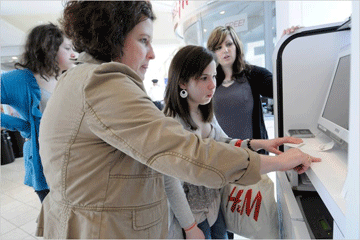New York Times’ Stephanie Clifford Talks about Crazy Sizing of Women’s Clothing!!
This is an excerpt from an extremely well-written article by Stephanie Clifford from the New York Times about the insanity of the inconsistent sizing of women’s clothing. I am going to excerpt parts of it here and then comment about it — because I am no slouch at being able to figure out what size I am. As a former stylist (photography, videos, fashion shows & celebs), fashion editor (online and in print) and consultant to fashion brands, I have some serious fashion credentials behind me. The frustration that women had at the height of the jeans trend had me writing 25 different versions of how to find the best-fitting jeans for your body type. I could even fit you over the phone and give you 3-5 brands and styles and one would be perfect.
However the fashion marketplace has changed a lot and this vanity sizing has gotten crazy. While you have to size up for H&M, Hollister, Abercrombie & Fitch, you have to size down for Lands End, LL Bean signature and Chicos. Even with size charts where I measured myself against their charts, the LL Bean Signature stuff was fall on the floor too big. So a size 2 is no longer a size 2 . To give you a hint, I am now a size 24 or 25 jeans, size 00 or 0 except in jackets where I need a size 2 because I have shoulders (thank you pilates and Exhale Core Fusion). What’s your average-sized woman going through to find clothes that fit her properly? How many times does a woman have to try on something (jeans, dresses, jackets, pants) before she finds something that fits?
Here’s what Stephanie Clifford had to say:
One Size Fits Nobody: Seeking a Steady 4 or a 10
In one store, you’re a Size 4, in another a Size 8, and in another a Size 10 — all without gaining an ounce.
It’s a familiar problem for many women, as standard sizing has never been very standard, ever since custom clothing gave way to ready-to-wear. So, baffled women carry armfuls of the same garment in different sizes into the dressing room. They order several sizes of the same shirt online, just to get the right fit.
Now, a handful of companies are tackling the problem of sizes that are unreliable. Some are pushing more informative labels. Some are designing multiple versions of a garment to fit different body shapes. And one is offering full-body scans at shopping malls, telling a shopper what sizes she should try among the various brands.
“For the consumer to go out and navigate which one do I match with is a huge challenge, and causes frustration and returns,” said Tanya Shaw, an entrepreneur working on a fit system. “So many women tie their self-esteem to the size on the tag.”

Laura Pedrick for The New York Times
In foreground, Liz Reviello and her daughter Alyssa use the results of the body scanner from MyBestFit to find the right size.
As the American population has grown more diverse, sizes have become even less reliable. Over the years, many brands have changed measurements so that a woman who previously wore a 12 can now wear a 10 or an 8, a practice known as “vanity sizing.”
In men’s clothes, the dimensions are usually stated in inches; women’s clothing involves more guesswork.
Take a woman with a 27-inch waist. In Marc Jacobs’s high-end line, she is between an 8 and a 10. At Chico’s, she is a triple 0. And that does not consider whether the garment fits in the hips and bust. (Let’s not get into length; there is a reason most neighborhood dry cleaners also offer tailoring.)
Ms. Shaw, the entrepreneur, is chief executive of a company called MyBestFit that addresses the problem. It is setting up kiosks in malls to offer a free 20-second full-body scan — a lot like the airport, minus the pat-down alternative that T.S.A. agents offer.
Lauren VanBrackle, 20, a student in Philadelphia, tried MyBestFit when she was shopping last weekend.
“I can be anywhere from a 0 at Ann Taylor to a 6 at American Eagle,” she said. “It obviously makes it difficult to shop.” This time, the scanner suggested that at American Eagle, she should try a 4 in one style and a 6 in another. Ms. VanBrackle said she tried the jeans on and was impressed: “That machine, in a 30-second scan, it tells you what to do.”
There is a great deal more to this article and brands like Levis and Gap have come out with jeans in different fits to accomodate different body types.
Clifford talks about other entrepreneurs who have tried to create systematic sizing with or without a lot of luck. There was a body scanning system out a couple of years ago guaranteeing you custom fit jeans– except it didn’t quite work that well. People were unhappy– particularly women because it meant traveling to the machine and measuring and then scanning and then getting a pair of jeans that distinctly did not fit.
What’s frustrating to customers is that the stores don’t provide the customer service they once did to make sure that the sales staff knows the difference — and often the average size American woman (size 12, 14, 16) are pushed into plus-size garments that like style, sophistication, quality construction and fabrics as well as a good fit. Clifford has done her homework on this assignment. I would love to see what the designers are going to do to standardize clothing sizes so that roaming from brand to brand doesn’t kill off the fashion industry due to their lack of consistent sizing — even within one brand. Looking for a pair of denim shorts at Gap, Old Navy and other spots, I could not find a pair that would fit me properly in the fabric or style I wanted. I wound up at Target paying $18 (instead of $60) for a pair of denim shorts. Why do women have to struggle to find the styles they want in the sizes that fit them?
Obviously there’s a lot more work to be done on fixing the system.
Stevie Wilson, LA-Story.com
Shop the Spring 2011 Color Collections at Beauty.com!
Subscribe to RSS headline updates from:
Powered by FeedBurner
If you want to feature content from LA-Story.com, please remember to linkback to the specific page & please email the link to [email protected]
LA-Story.com, LA-Story Recessionista, Celebrity Stylescope, Celebrity Style Slam Trademark/Copyright: KBP Inc. 2007-11











